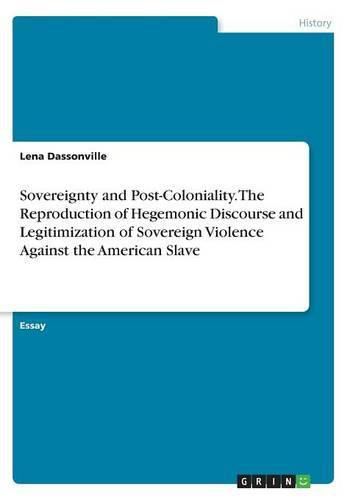Readings Newsletter
Become a Readings Member to make your shopping experience even easier.
Sign in or sign up for free!
You’re not far away from qualifying for FREE standard shipping within Australia
You’ve qualified for FREE standard shipping within Australia
The cart is loading…






Essay from the year 2016 in the subject History - America, grade: A, course: History of the United States, language: English, abstract: I aim to explore the question of American slavery in the mid 19th century by looking through literary, legal, and post-colonial lenses in an effort to show how abolition-era literary narratives utilize stereotype to reproduce a racist discourse and, further, how legal documents and actions reduce the slave to ‘homo sacer’ through a state of exception, ultimately making the slave the subject of legitimized sovereign violence. Uncle Tom’s Cabin, published in 1852 by Harriet Beecher Stowe, is an anti-slavery, abolition-era narrative detailing the lives of a black slave family in the south. Though written with good intentions and anti-slavery sentiments, Stowe deploys a hegemonic ideology by confining slaves to their stereotypic bounds-lamenting slavery while utilizing a typical, Africanist-African-American depiction of slaves. Stowe reproduces a racist discourse by constructing stereotypical characterizations of black slaves; specifically their appearance and how they behave in comparison to their white counterparts.
$9.00 standard shipping within Australia
FREE standard shipping within Australia for orders over $100.00
Express & International shipping calculated at checkout
Essay from the year 2016 in the subject History - America, grade: A, course: History of the United States, language: English, abstract: I aim to explore the question of American slavery in the mid 19th century by looking through literary, legal, and post-colonial lenses in an effort to show how abolition-era literary narratives utilize stereotype to reproduce a racist discourse and, further, how legal documents and actions reduce the slave to ‘homo sacer’ through a state of exception, ultimately making the slave the subject of legitimized sovereign violence. Uncle Tom’s Cabin, published in 1852 by Harriet Beecher Stowe, is an anti-slavery, abolition-era narrative detailing the lives of a black slave family in the south. Though written with good intentions and anti-slavery sentiments, Stowe deploys a hegemonic ideology by confining slaves to their stereotypic bounds-lamenting slavery while utilizing a typical, Africanist-African-American depiction of slaves. Stowe reproduces a racist discourse by constructing stereotypical characterizations of black slaves; specifically their appearance and how they behave in comparison to their white counterparts.